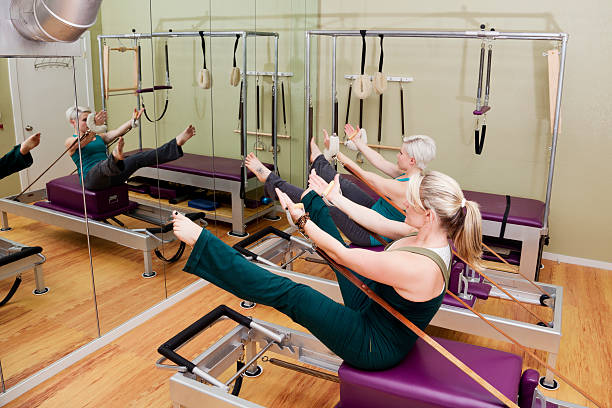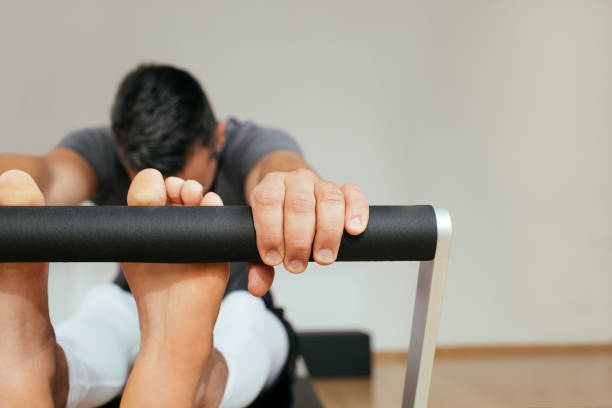Pilates requires precise movement and control. It also builds concentration and awareness of your body, which can carry over to other parts of your life.
It’s a low-impact workout that strengthens the core and helps develop flexible muscles. That flexibility can help you avoid injuries in sports or other exercise, as well as reduce back pain.

Strength
The Pilates workout requires concentration and attention to the detail of each movement, helping you build strength while remaining calm. This focus on slow, deliberate movements helps strengthen the small stabilizer muscles of your core that are often overlooked in other exercises. This strength is not only essential for supporting your back and spine, but also your balance and coordination, reducing the risk of injury during other physical activities, like walking or reaching over to grab something off a shelf.
Pilates Caulfield also requires you to engage the larger muscle movers of your body, such as the arms and legs. The combination of these small and large muscle groups is what pilates makes so unique, providing a total body workout that will leave you feeling strong.
The practice of Pilates requires a deep awareness of your body, including your breathing and posture. This mindfulness can translate into your daily life, helping you be more aware of how you move and how you carry yourself. It can even help reduce your stress levels by teaching you how to control and move your body in a more graceful, mindful way.
Pilates is a low-impact workout that can be modified, progressed and regressed for any level of ability. While it is safe for almost everyone, it’s a good idea to talk to your doctor before starting any new workout routine, especially if you have any chronic health conditions or injuries.
Flexibility
Pilates teaches you to focus on the present moment, and requires full concentration of body movements. This mindful practice promotes a sense of calm that can be used in other aspects of life, reducing stress and improving overall mental clarity.
Pilates also helps improve balance and core strength. This enables you to perform daily tasks with ease and confidence, as well as reduce your risk of falls and injuries. In fact, a study showed that participants who regularly completed a 10-session Pilates regimen experienced significant improvements in their dynamic balance compared to those not doing Pilates.
The individualized nature of Pilates exercise, which incorporates movement at a slower pace with more repetitions and a lower load on the joints, also makes it ideal for older adults. The low impact and controlled movements help to keep joints lubricated and protected from overuse, which can lead to stiffness and pain.
A regular Pilates routine can also help with issues such as menstrual cramps and dysmenorrhea, which are often caused by an imbalance between the uterus and pelvic muscles. Studies have shown that practicing Pilates can increase abdominal muscle strength and improve posture, which in turn reduces symptoms of dysmenorrhea (5).
A good Pilates instructor will take the time to understand your goals and make recommendations that are safe and effective for you, regardless of your age or fitness level. It’s important to find an instructor who is certified through a reputable organization, offers modifications for different body types, postural concerns and injuries; communicates clearly; demonstrates and cues properly; layers and progresses exercises appropriately; and seeks out ongoing education and training to enhance their knowledge base and skills (4).

Posture
Pilates emphasizes proper posture, which strengthens and retrains the muscles of the spine. This helps balance out the muscular imbalances of the body that can cause pain and chronic musculoskeletal issues over time. Additionally, Pilates improves balance and coordination by teaching students to engage the small stabilizing muscles that support their bodies. This increased proprioception can reduce the risk of falls and other injuries by improving balance and enhancing movement efficiency.
In addition, Pilates incorporates rhythmic breathing that can encourage mindfulness and a sense of awareness of the present moment. Focusing on your breath allows you to quiet the “monkey mind” and brings the mind and body into a state of calm. It can also help relieve stress and promote the release of feel-good chemicals, like serotonin.
To get the most out of your Pilates workout, it’s important to work with a qualified instructor who can instruct you in the correct form and technique for each exercise. A quality instructor will take the time to carefully teach each client how to perform the exercises correctly and at a safe level for their specific body. They will offer modifications for any injuries or other limitations; communicate effectively; layer and progress the session appropriately; and pursue ongoing education and training.
Breathing
Breathing is essential for movement because it provides oxygen to the muscles and eliminates carbon dioxide. Pilates utilizes the perfect tempo of deep full inhales and exhales, ensuring the body gets enough oxygen during exercise while also eliminating waste products. Incorporating breathing into a Pilates session helps to alleviate pain by activating the parasympathetic nervous system which promotes relaxation and reduces pain perception. For example, the ‘Hundred’ exercise uses a specific count of 5 inhales and 5 exhales to ensure blood is flowing properly while performing a core challenging movement that can increase heart rate.
Proper breath during Pilates is a form of conscious, mindful breathing that can help improve balance, coordination and posture. This type of breathing also encourages blood flow, which can help stabilize emotions and make it easier to focus. In addition, this type of breathing can help decrease the time it takes to fall asleep and increase sleep quality.
Pilates teaches lateral breathing that focuses on expanding the sides and back of the ribcage rather than filling the abdomen. This helps to activate the abdominal muscles and strengthens the spine. It also teaches you to breathe through movement, inhaling during preparation and exhaling during exertion which synchronizes muscle contractions, helping you build strength and endurance. Mindful breathing can also help prevent unnecessary tension or strain, especially in the abdominals, which can cause injury.

 February 22nd, 2024
February 22nd, 2024  adminva2
adminva2  Posted in
Posted in